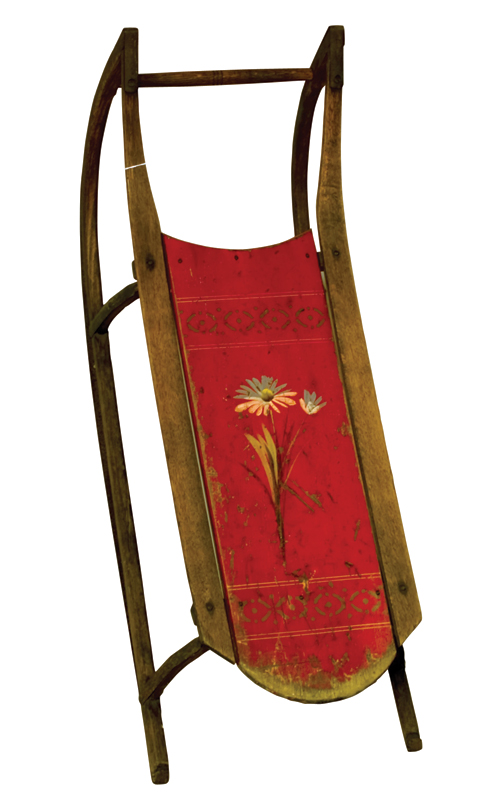Antiques: Sleds
Edith Wharton got it all wrong in Ethan Frome. That tortured farmer from Starkfield, Massachusetts, took a suicidal sled run down an icy slope and, tragically, lived to regret it. Perhaps most tragic was that Frome’s thinking on sledding was flawed from the start. He looked at it as a way to end his days. […]

Coffee By Design | Portland, Maine
Photo Credit : Katherine Keenan
Photo Credit : Inc., Skinner
Sledding goes back many, many centuries. Lore has it that Roman soldiers used their shields to sled down hillsides in battle. In America, sleds and toboggans, like the early sledges used by ancient civilizations around the world, were first used to haul timber, stones, supplies, and so on, but by the 1840s, downhill coasting sleds were being manufactured for recreation. Sled racing soon became a popular sport, and in 1861 Henry Franklin Morton, of West Sumner, Maine, became the first large-scale sled maker in the country.
Like most rags-to-riches stories, Morton’s tale is a quirky and interesting one. A serious eye malady affected his ability to pursue a livelihood, so Morton began making rakes and sleds for extra money. His wife, Lucilla, painted them in their kitchen. His venture was so successful that by 1862 he had hired staff, moved a few miles south, and formed the Paris Manufacturing Company. Coasting sleds, ice sleds, and sleighs made of oak, with fixed runners of wood or iron, were hand-painted or stenciled by local artisans. His firm grew to become the largest and longest-running sled manufacturer in the country’s history, with a string of branch stores nationwide by 1900.
“What makes these sleds so desired by collectors is the hand-painted imagery,” notes Garrett Sheahan, generalist appraiser at Skinner, Inc. “It’s typically lively and colorful, connoting a sense of speed, grace, adventure, or beauty.” “Clippers,” made for boys, were low, sleek coasters, many of them depicting sporting images, animals, or the names of famous racehorses or sailing ships. “Cutters,” sleds for girls, were fashioned as dainty sleighs adorned with birds, cherubs, and nature scenes.
Basic models sold for as little as 60 cents. Top-of-the-line models included “Black Beauty,” which sold for $2, and the elaborate “Snowy Fairy,” a girl’s sled with miniature bells attached to fanciful runners, which sold for $4. By 1910, however, modern steerable sleds such as the Flexible Flyer (patented in 1889 by Samuel Leeds Allen of Pennsylvania) had caught on, and Paris’s hand-painted sleds became a thing of the past. (In an interesting turn of events, Paricon Inc., direct descendant of Morton’s family firm, makes the Flexible Flyer line these days.)
Today, collectors of antique sleds spend anywhere from $300 to several thousand for examples in good condition. The fancier the decoration the better; the best examples date from the 1860s to 1890. Look for vibrant colors and normal wear, but no peeling or cracking.
The most famous sled of all, a clipper named “Rosebud,” from the Orson Welles movie classic Citizen Kane–or more specifically, one of three balsa-wood Rosebud props used in the movie–sold at auction in 1982 to Steven Spielberg for $55,000 (plus 10% buyer’s fee). Rosebud’s red-painted pine prototype sold to another collector in 1996 for $233,500. Come to think of it, a sled race and a bidding war have a lot in common: a steady climb, a wild ride, and a long, slowing finish. In the end, victory goes to the one who can go the distance.
Catherine Riedel represents Skinner Auctioneers and Appraisers of Boston and Marlborough, Massachusetts. 617-350-5400, 508-970-3000; skinnerinc.com







